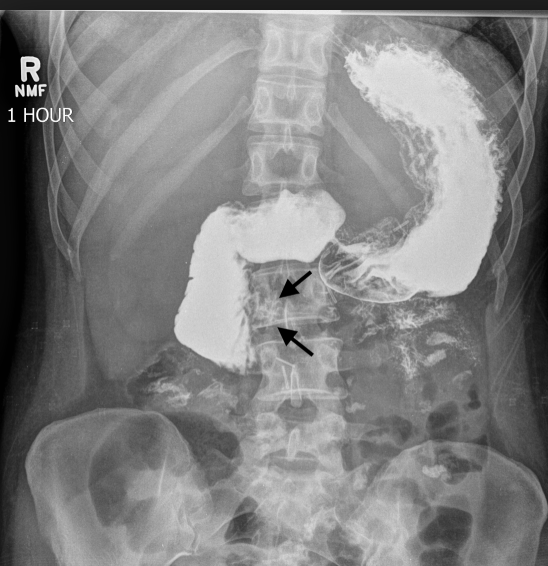A 22 y.o. woman presents with vomiting and weight loss
What does her upper GI show?
the arrows point at the problem
Our patient had a duodenal obstruction from superior mesenteric artery syndrome. She had compression of the third portion of the duodenum between the superior mesenteric artery and the aorta. The syndrome was first described in 1861 by Von Rokitansky. The incidence is reported to be 0.1-.3%
It can occur after scoliosis surgery, anorexia with weight loss, rapid growth in adolescence, or trauma.
an angle of 20 degrees between the sma and aorta is considered likely to cause sma syndrome
The greatest barrier to making the diagnosis is not to think of it. Delay in diagnosis can result in malnutrition, electrolyte abnormalities, a duodenal bezoar or even gastric perforation. The symptoms are typically relieved when the patient is in the L lateral decubitus, prone or knee to chest position.
surgical correction of sma syndrome with a duodenojejunostomy
Surgical correction is recommended if conservative measures fail. The standard procedure is a duodenojejunostomy where an anastomosis is created between the duodenum and jejunum anterior to the superior mesenteric artery.
sma syndrome can be diagnosed on Ct as well. the large white arrow is the dilated duodenum, the small black area is the compressed distal duodenum and the two small black arrows show the closeness of the sma and aorta. with the duodenum compressed between.
Our patient underwent a duodenojejunostomy which was complicated by a wound infection and contained duodenal leak. She recovered and is now able to eat whatever she wants without vomiting.
Gerasimidis T, George F. superior Mesenteric Artery Syndrom. Dig Surg 2009. May 20. 26(3):213-14.
Saraya T, Kurai D, Ariga M, Nakamoto K, Koide T, Tamura M. Superior mesenteric artery syndrome caused by huge mycotic abdominal aortic aneursym. Intern Med. 2009. 48(12):1065-8.
Pottorf BJ, Husain FA, Hollis HW Jr, Lin E. Laparoscopic management of duodenal obstruction resulting from superior mesenteric artery syndrome. JAMA Surg. 2014 Dec. 149(12):1319-22.
Rokitansky C. Handbuch der Pathologischen Anotomie. Vienna: Branmiller and Siedel. 1842.



